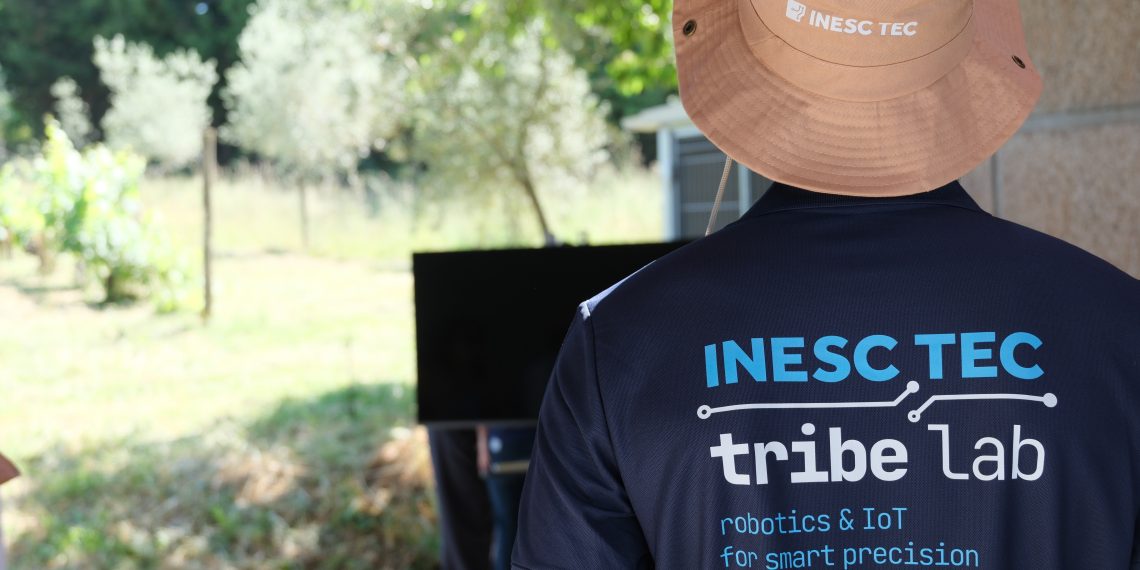A (r)evolution is underway in the agricultural, viticulture, and forestry sectors, driven by technology developed by INESC TEC. On June 26, the University of Trás-os-Montes and Alto Douro (UTAD) hosted Synergy Day by INESC TEC 2025 – Robotics and IoT for Smart Precision Viticulture, an event that showcased how robotics, Artificial Intelligence (AI), and the Internet of Things (IoT) are helping make the European precision viticulture sector more multidisciplinary, innovative, and efficient.
The day began in UTAD’s Geosciences auditorium, with various talks on the current landscape and future of smart precision viticulture. In the afternoon, attention shifted from the auditorium to the vineyards, where demonstrations of technologies in robotics, AI, and IoT took place. Close to 100 participants walked through the vineyards to witness first-hand the potential of these technologies and the advantages of their use in pursuing more sustainable and efficient practices – reducing resource waste and minimising environmental impact. Questions were raised, new challenges proposed, and researchers left with “seeds” of inspiration for future projects.
Right in the heart of the vineyard, participants observed how the PRySM and WETA robots operate in the context of intelligent precision spraying. The MowIT tool, integrated into the Modular-E robot, demonstrated how vegetation in vineyards can be managed using sensors to detect plant cover and make real-time decisions about the most suitable actions – both along the rows and between them. The Nutridrop system enables targeted, precise nutrient application directly to the base of each vine. Also showcased was OmicBots, a robotic manipulator designed to establish causal links between spectral information and metabolite concentrations in plant tissues (leaves and fruit), shedding light on plant physiology considering the agronomic context.
As for IoT-related technologies, participants gathered near the winery to hear from the experts. One of the highlights was Wine4cast, an application developed to forecast vineyard productivity using automated phenotyping of yield components. It includes an innovative system that overcomes limitations caused by inflorescence or bunch occlusion, ensuring detection accuracy. In addition, the SharpMetriX tool uses sensor integration, advanced processing technologies, and georeferencing to generate high-resolution productivity maps during harvest. These maps provide indicators for efficient labour management, aligned with a viticulture 5.0 approach. Also on show was MOXOH, an intelligent system for early detection of pests and diseases, and AgWearCare, a wearable device-based tool that monitors agricultural workers’ well-being in real-time, tracking metrics such as body temperature and heat exposure.
“Synergy Day by INESC TEC is designed to highlight the latest results of our research and technological development,” said Filipe Neves dos Santos, a researcher at INESC TEC. “The solutions demonstrated were developed to address real needs and aspirations of the viticulture sector and are now being tested in operational contexts. These technologies are ready to help shape the future of viticulture in Portugal and have the potential to be exported across Europe through our business partners – the real technology adopters.”
Technology with purpose: meeting challenges, finding solutions
The event opened with a talk by António Graça (Sogrape Vinhos), who outlined the challenges and costs associated with managing viticulture, sparking discussion around the sector’s needs and opportunities. He emphasised that investing in R&D in these areas is not about “replacing people with robots,” but rather about “real-time management and control of decisions, and our desire to engage early with new developments, so we can prepare ideas, concepts, and ways of thinking adapted to new technologies. We want to address future challenges – not past issues,” he said.
For companies like Sogrape Vinhos, collaborating with researchers at INESC TEC means co-creation, with the benefit of gaining insight into both the limitations and possibilities of developing new concepts. “Testing on the spot and understanding what’s missing leads to highly effective customisation solutions and makes us more creative and productive,” added António Graça, who noted that “thinking about the vineyard in terms of machinery no longer makes sense.”
Also present was Jochen Hemming of Wageningen University & Research, an international authority in agricultural robotics.
Representing INESC TEC, Lino Oliveira took the stage in the morning to speak about the evolution of this field in the digital world. He discussed the potential of generative AI and geospatial knowledge infrastructures in smart precision agriculture, offering a holistic view of how data can be turned into real-world solutions. “Can we use LLMs in agriculture? If so, how? By using our own data and knowledge to test our own models – the more data, the better,” he mentioned.
Filipe Santos also shared the progress and ambitions of TRIBE LAB – INESC TEC’s lab for robotics and IoT applied to smart precision agriculture and forestry -, highlighting the multidisciplinary approach and contribution to viticulture technology.
Synergy Day by INESC TEC 2025 was part of the Institute’s 40th anniversary, and co-organised with UTAD – which hosts one of INESC TEC’s research centres; ADVID and Sogrape also supported the event.
The researcher mentioned in this news piece is associated with INESC TEC.



 News, current topics, curiosities and so much more about INESC TEC and its community!
News, current topics, curiosities and so much more about INESC TEC and its community!